|
|
Whisker

|
|
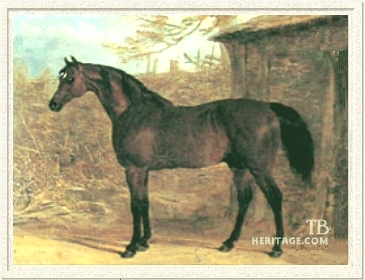 |
|
|
Whisker was a good, but not outstanding, runner, who won the Epsom Derby in a hard-fought, exciting race that lingered long in the memories of those who saw it. Like his brother, Whalebone, he became an excellent sire, particularly of stayers. Two sons established sire line branches that extended to the end of the 19th century, one in Australia, and one that ended in the U.S. His daughters could also stay, and in the breeding shed produced classic winners, sons that became good sires, and daughters that left a lasting legacy.
"Bred in the Purple" from the great female family of Julia (1756, Family 1), his grandam, Prunella(1788), was by one of the most important sires and racehorses of the day, Highflyer. She produced classic winners and dams of classic winners, and the stallion Waxy Pope, who was nine times leading sire in Ireland. Her daughter, Whisker's dam, Penelope (1798, by Trumpator) was a top racehorse who beat both colts and fillies during her five years of racing. Retired to stud, she was an exemplary broodmare who produced, in addition to Whisker, his brother Whalebone, a good racehorse and sire of sires, and Woful, sire of two classic winners. Her daughters, in their turn, also became outstanding broodmares, particularly Whisker's sister Web (1808), ancestress of Glencoe and Bay Middleton, among others, and Wire, who in Ireland, bred Verulam, a good runner and later sire of Wanderer, the 1855 Irish-bred Grand National winner. Wire established a tail-female line that included Uncas, a leading sire of steeplechasers in 1880s and Hilarity, who won over fences and was third dam of Ascot Gold Cup winner Santoi, a sire of good stayers and steeplechasers.
Whisker's sire, the bay 1793 Derby winner Waxy, grandson of Eclipse and from a Herod mare, was a sucessful sire of sires and broodmares.
Whisker was the product of a deliberate and highly successful breeding program at the Euston Stud in Suffolk, established by Augustus Henry FitzRoy, (3rd) Duke of Grafton (1735-1811), a descendant of King Charles II and his one of his mistresses, Barbara Villiers. Grafton had used the Eclipse son Pot-8-Os (1773) with the female descendants of Herod in his stud, and then Pot-8-Os's son, Waxy (who he was finally able to purchase in 1808), who he bred repeatedly to both Prunella and her daughter by Trumpator, Penelope. This highly successful nick led to the Grafton stud's dominance in racing and breeding in the first quarter of the nineteenth century; twenty-six classic winners emerged from the Grafton stud between 1802 and 1831, many of them from the Grafton's Julia descendants.
Whisker was a rich bay, born a year after the death of Augustus Fitzroy (3rd) Duke of Grafton. For his son, George Henry, the 4th Duke, Whisker won the Derby and other races, before being sold to William Henry Vane, (3rd) Earl of Darlington, later (1st) Duke of Cleveland. Whisker was generally considered to be the best-looking of Waxy's offspring, according to the The Druid, "as near perfection in look as anything could be," although a little "calf-knee'd." His trainer was the great horseman Robert Robson, known as "The Emperor of Trainers," who schooled four Derby winners, Whisker being the last, for the Dukes of Grafton, and two more for other owners, and thirteen Guineas winners for the fourth Duke between 1819 and 1827.
Whisker on the Turf
Like most of Robson's charges, Whisker was started at age three; in his first two outings he received a 100 guineas forfeit, and then a 50 guineas from the Orville son, Dinmont. His next race was the Two Thousand Guineas, won by Tigris, in which he did not place. At the same Newmarket First Spring meeting, he ran second in the Newmarket Stakes, won by Clinker son, Busto. He went on to Epsom for the Derby, which he won, beating eleven others, in an exciting race where he ran head-to-head with Rubens son Raphael, beating him by 1/2 head. Racing journalists spoke of it as the best Derby race within memory. Whisker's next race was the Newmarket St. Leger stakes, in which he did not place. At the Newmarket Second October meeting he won a 200 guineas match against Donkey, a Bobtail son, and at the same meeting lost a match for 300 guineas to Sir Joshua.
In 1816, age four, Whisker started by winning the Post Stakes at Newmarket Craven. He went on at Newmarket First Spring to win a match against Paulus, and at Newmarket Second Spring, beat Sir Joshua in a 300 guineas match. In the fall, he received a compromise from Paulus at Newmarket Second October. After this race, he was sold to William Harry Vane, (3rd) Earl of Darlington. At Newmarket Houghton meet, in his new owner's colors, he was beaten by Equator (carrying 7 st. 13 lbs.) in a 200 guineas match in which he carried 8 st. 6 lbs. Also at Newmarket Houghton he won a race in which he beat the filly Duenna, who was second in both the One Thousand Guineas and the Oaks that year. He ran unplaced in his last race that season.
Whisker did not run in 1817. In 1818, he beat Little Dick in a 200 guineas match, and the aged Cannon Ball in a 200 guineas match over two miles, both at Newmarket First Spring. At Newmarket Second Spring he won a 200 guineas match against Manfred, carrying ten more pounds. He failed to win in his succeeding four races, and was retired from the turf.
Whisker in the Stud
Retired to stud in 1818 near Catterick, in Yorkshire, and later spending some time at the Vane's famous Raby Castle stud, Whisker was, said The Druid,"...equally likely to get a racer, hunter, machiner, or hack." Even setting aside (his famous daughter) Emma, he said, "the Whisker mares have always been out of the common way." He was well-patronized by leading north country sportsmen, including Richard Watt, master of Bishop Burton Stud in Yorkshire, the Duke of Leeds, the Peirse family, and many other long-time breeders in Yorkshire and Durham.
Whisker sired two St. Leger winners, Memnon and The Colonel, both good winners and stayers, staying being a characteristic of almost all of Whisker's progeny. The Colonel's son, Cap-a-Pie, took Whisker's sire line to Australia, where it flourished through Cap-a-Pie's son, Sir Hercules, the best Australian-bred sire until superceded by his son, Yattendon, and continued by Yatendon's sons, Melbourne Cup winners Chester and Grand Flaneur (1877), and Chester's son, Abercorn. Another good running Whisker son was Emancipation, whose daughters were influential in the U.S., where he was ultimately sent to stud, and in France. A less successful Whisker son on the turf, Economist, was sent to stud in Ireland, where he got Harkaway, who continued the sire line in Great Britain primarily through his son King Tom, its representatives later migrating to the U.S.
Both The Colonel's and Economist's sire line branches petered out, towards the end of the 19th century. However, Whisker's daughters, some of which were good runners, were outstanding producers, by and large, with immediate success as broodmares and dams of classic winners, and influential in many female families in Great Britain, in France, and indeed, throughout the world.
|
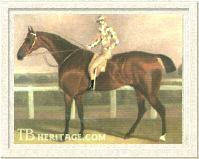
Memnon | | MEMNON (1822) was a product of Richard Watt's Bishop Burton Stud in Yorkshire, from whence issued three Doncaster St. Leger winners, an Oaks winner, and many great distance runners in the first decades of the nineteenth century. Memnon's dam, Manuella (1809), by Dick Andrews, was a Bishop Burton product who ran for two years, her best win the Epsom Oaks; she raced for W.N.W. Hewitt, and returned to Bishop Burton when her career on the turf was done. She was out of Watt's exceptional broodmare, Mandane, also the dam of St. Leger winner Altisidora, the great stayer Lottery and Brutandorf. Manuella was also the dam of Memnon's sisters NITOCRIS and MARGELLINA (see below). |
Memnon was unbeaten in his two juvenile races, Doncaster's Champagne Stakes and a sweepstakes worth 380 guineas at the same meeting. The next year he started his season by winning the York St. Leger, and followed that by winning the Doncaster St. Leger, beating The Alderman, July Stakes winner Redgauntlet, Chateau Margaux, Actaeon, and a number of other good runners in the biggest field for that race to that date (thirty horses). His jockey, Bill Scott, had won one St. Leger, and went on to win seven more. Memnon's last race that year was a walk-over for the Gascoigne Stakes at the Doncaster meeting. After the meet Memnon was sold to Lord Darlington for £3,500.
In the months before the Doncaster St. Leger, Memnon became a heavy favorite, spurred by a huge sum at 1,000 to 25 wagered by Yorkshire gambler and later owner, John Gully two months prior to the race; bookmakers had taken long odds on Memnon, and after his York St. Leger win, one, who had laid a huge amount against Memnon, offered to purchase Memnon for 4,000 guineas before the race. Watt refused, stating, "Until the St. Leger of Doncaster has been run Memnon belongs to the public, and money wouldn't buy him." Interest in this race was so great that the results were sent to London via carrier pigeons, an early use of this means of long-distance communication.
At age four Memnon ran second to the good runner Signorina in the Manchester Cup. At York August he ran second to Actaeon in the four mile Great Subscription Purse. At Doncaster, he took a walk-over for 60 sovereigns, and at the same meeting he won a race worth £250 over four miles, beating Florismart, Amadis and two others. The next year, 1826, his first race was a 1,000 sovereign match against the Phantom colt Enamel, which he won. That was followed by winning the Ascot Gold Cup, beating four horses. He then went back to Doncaster, where he was beaten by the great race mare Fleur-des-Lis in the Doncaster Stakes, and then dead-heated with her for second place in the Doncaster Cup (won by Mulatto). His last win was the receipt of a forfeit in a scheduled match over three miles against The Alderman at Newmarket Houghton.
In his final season, he ran fifth and last in Mameluke's Oatlands Handicap at Newmarket. At Newmarket Second Spring he ran third to Chateau Margaux in the Jockey Club Plate. He had been scheduled to run for the Whip at Newmarket in October, but was retired to stud and paid forfeit to Lamplighter.
Not a big success at stud at Raby Castle in England, although he got King Cole (1833), who won the Chester Cup, he was sold to Russia around 1833, and had some influence on race horse breeding there through his daughter, Lady Fairy (1836) and sons Czudo (1834) and Sygnal (1840), the latter a good broodmare sire.
|
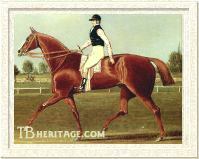
The Colonel | |
THE COLONEL, a blaze-faced chestnut bred at the Wyvill Constable Burton stud, Yorkshire, in 1825, was out of a mare called My Lady's dam, by Delpini. A successful family descends from Gascoigne Stakes winner My Lady (1818, by Comus, Family 8 - k), with stakes winners all over the world; DELPHINE, by Whisker (see below) was a daughter of My Lady. The Colonel was purchased by Edward Petre as a yearling, and was sold, after his St. Leger win, to King George IV for £4,000. He was a small, speedy horse, "high and fighting" in his action, and even as an aging stallion was called "the beau-ideal of an English Thoroughbred." He was in-bred 4 x 4 to Eclipse, 4 x 4 to Herod, 3 x 4 to Highflyer, 4 x 5 to Blank, 5 x 5 to Snap.
|
The Colonel stood at stud at Hampton Court, and when the king's stock was dispersed by auction in 1837 by Tattersalls, was purchased for 1,550 guineas by Richard Tattersall, and sent to the Tattersall farm at Dawley, near Uxbridge. He was sent to Brunswick, Germany, in 1838; he was returned to Tattersall in 1843, and placed at Tattersall's Willesden Paddocks in Kilburn, where he ended his days in 1847.
The Colonel won all three of his races as a juvenile: a race for two year olds at Haigh Park, a 100 sovereign race at Pontefract, and the Champagne Stakes at Doncaster.
At age three, he came out for the Derby, dead-heating with Cadland, and in the run-off was beaten by half a neck. His next race was the Doncaster St. Leger, which he won, beating a very good field, which included Velocipede, the good Blacklock daughter Belinda, and the great runner Bessy Bedlam. He followed this by walking over for a rich sweepstakes at the same Doncaster meeting, after which Petre sold him to King George IV, who, according to The Druid, said "Buy, Buy," and "never rested till he had bought him" after seeing one of J.F. Herring's sketches of him and confirming it was a like portrait.
The following year was a peculiar one for The Colonel. Petre, before The Colonel's sale, had made a match against Bessy Bedlam, and rather than run, a forfeit was paid to her. His only other race was the Ascot Cup, won by Zinganee, in which The Colonel ran unplaced. It was alleged that, a few days before the race, a drunken groom or somone else had run the unplaced The Colonel over 12 miles to an inn outside of Ascot in the dead of night, and back again, ruining his chances in the race.
In 1830 he started by winning the Craven Stakes at Epsom, beating Harold, the Whisker daughter CLIO, and eight other horses. He next ran second to the great Reveller daughter, Lucetta, in the Ascot Gold Cup, beating Oaks winner Green Mantle and Zinganee. King George IV died that June, and The Colonel became the property of his brother, King William IV. He won a race at Stockbridge, and then went to Goodwood, where he ran third to Fleur-de-Lis and Zinganee, beating six others. He went on to win the Great Park Stakes at Ascot, and took a walk-over for the Northampton Cup.
At age six his first race was Epsom's Craven Stakes, in which he beat the good Whisker mare Fortitude and six others. At Ascot, he ran a dead heat for the Oatlands Handicap with the 1829 Clearwell Stakes winner Mouche, and then injured his fetlock in the run-off, terminating his turf career.
The Colonel was not destined to become a prominent sire, possibly due in part to his lack of good management at Hampton Court, and then his lack of reputation by the time Tattersall bid for him "soley to keep him out of foreigner's hands," and then his subsequent five years in Germany. His daughter Arsenic (1833) produced Oaks winner Poison (1840) by Plenipotentiary. Another daughter, Post Haste (1833), out of Orville daughter Posthuma, won seven races. Of his sons, Cap-a-Pie (1837) and July and Criterion Stakes winner Chatham (1839) were probably the best. Chatham got Sittingbourne, a good winner of the Convivial Stakes at York, Newmarket's Prendergast Stakes, Goodwood's Gratwicke Stakes, and Newmarket's Triennial Produce Stakes; he ran second to West Australian in both the Two Thousand Guineas and the Derby; Chatham is seen in the pedigree of Pero Gomez.
Cap-a-Pie was shipped off to Australia for stud duty, where he did very well, continuing Whisker's sire line through a series of great racehorses and sires, extending from his son, (Australian) Sir Hercules (1843), through Yattendon (1861), Chester (1874), and Abercorn (1884), all extremely influential in Australian pedigrees. Yattendon's son, Melbourne Cup winner Grand Flaneur (1877), also was a good sire, but his sons were not as successful at stud as Chester's son, Abercorn.
Another good-running Whisker son was EMANCIPATION (1827), out of an outstanding broodmare by Ardrossan, who also produced Doncaster Cup winner Tomboy (1829 by Jerry) and the great race mare Bee's Wing (1846 by Dr. Syntax), and a number of other winners. He was bred and raced by Ralph Riddell, of Felton Park, Northumberland, the owner of Dr. Syntax; Emancipation was later sold to the Duke of Cleveland for 1800 guineas. He ran third in Birmingham's 1830 St. Leger, and the following year emerged as a good distance horse, winning the Stanley Stakes and the Gold Cup at Preston, and the Fitzwilliam Stakes at Doncaster. His other achievements included a second win of the Preston Gold Cup, the Craven Stakes, a match against Priam, in which he received a forfeit, and he ran second to The Saddler in the Doncaster Cup.
Emancipation stood in England for a couple of years, and then in 1835 was purchased by Merritt & Co., bloodstock dealers based in Virginia, and became a successful sire in the U.S. In the U.S., his daughter, Sally Morgan, produced a very good four-mile race horse in Panic (1859, by Glencoe), and was tail-female ancestress of a number of U.S. Stakes winners through the mid-20th century, including Wise Counsellor (1921). A British Emancipation daughter, Jessie (1835, from Smolensko daughter Eliza), was second dam of the influential American sire, Bonnie Scotland, and also left a lasting female line which included the great French broodmare, Gladia (1874), from whom descended the French winner Gouvenour and French classic winners Govenor, Gospodar, and the great race horse Gouvernant. Several French classic winners also descend in tail-female from Emancipation's in-bred daughter, Petronille (1835, by Whalebone).
The bay ECONOMIST (1825) from the Octavian (1810 St. Leger winner, and unbeaten at York) daughter Floranthe, was in-bred 4 x 4 to Eclipse, and 4 x 5 x 4 to Herod. He was the son that continued Whisker's sire line in Great Britain -- and later the U.S. -- through his great Irish son, Harkaway. Also, through a daughter, Economist was great-grandsire of Stockwell. Howe Peter Browne, (2nd) Marquis of Sligo, one of Ireland's largest landowners and a racing enthusiast, owner and breeder on both sides of the channel (and in the 1830s, Governor of Jamaica), purchased Economist as a yearling. He won several races, and ran second in the 1829 Preston Cup, won by Laurel, but was unplaced in Doncaster's St. Leger.
Economist was retired to stud at Curragh Lodge at The Curragh in Ireland. He sired Harkaway (1834) from Fanny Dawson, a mare by Nabocklish (by Rugantino), bred by Richard Thomas, Baron Cremorne, and given to the crack steeplechase rider Tom Ferguson. Harkaway, a big, blaze-faced yellow sorrel, won eleven races in Ireland, and in England the Goodwood Cup, among other races; his career encompassed 25 wins in 38 starts. Harkaway got Queen Bee, who established a famous family of runners in Ireland, and King Tom (1851, out of Pocahontas), a good stayer whose turf career was limited due to several injuries; in the stud King Tom got Derby winner Kingcraft; Oaks, One Thousand Guineas and St. Leger winner Hannah; Oaks winners Hippia and Tormentor, and a number of other good horses. This sire line continued through less distinguished King Tom sons, such as King Lud (1869), King Ban (1876), Great Tom (1878), King Ernest (1869), and Phaeton (1866), the latter four all imported into the U.S. Of these, King Eric (1887, a son of King Ernest) got Dick Finnel (1904), who sired some moderately succesful sire sons, and Phaeton sired both Ten Broeck (1872), a great racehorse, but not a successful sire, and King Alfonso (1872), who got classic winners in the U.S. and Grand Prix de Paris winner Foxhall. Quite a few good steeplechasers in England, Ireland, America and France descended from Harkaway (grandsire of Cortolvin and great-grandsire of Come Away, both Grand National Steeplechase winners) and King Tom, including Grand National Steeplechase winners The Soarer (1869, by King Tom's son Skylark (1873), Empress, from King Tom's daughter Jeu de Mots, and Pathfinder, by King Tom's son, Morgador.
King Tom was also the sire of St. Angela, dam of the undefeated racehorse and great sire, St. Simon, and of Angelica, the dam of the champion runner and influential sire, Orme.
Economist also sired the big "fiddle-headed" filly Echidna (1838) from George Watts' mare, Miss Pratt, by Blacklock. She never raced, but in the stud produced St. Leger and Cesarewitch winner The Baron (1842, by Birdcatcher); The Baron later got "the Emperor of Stallions," Stockwell, the great French race filly La Toucques, and three winners of the French Oaks.
SWISS (1821, out of a mare by Shuttle) was bred by William "Billy" Peirse of Bedale, Yorkshire, and sold to Colonel Cradock, a north country sportsman who ran several good horses in the '20s and '30s in the St. Leger, but never won the race. With Peirse as trainer, for Cradock, Swiss won Doncaster's Champagne Stakes at age two, and was an early favorite for the Doncaster St. Leger, in which he did not run. Peirse considered Swiss one of the best two-year-olds he had ever trained, but Swiss had a vicious temperament, and savaged a stable boy so severely that his leg had to be amputated. In England Swiss left a daughter, Lustre (from the Comus mare Lunette), whose daughter, Georgette (1839), produced French Oaks winner Geologie (1856) and other good winners in France, and a daughter, Geolette (1855) that was dam of the French staying filly Etoile Filante and French Two Thousand Guineas winner Gouvenar. Swiss got a few other fillies that bred on, and then was sold to the U.S., imported by F.B. Ogden, where he had little success as a sire.
Other Whisker sons with some racing credentials included MUSTACHIO, owned by north country magnate William Russell, who was a good cup horse; he ran second to Lottery in the 1825 Preston Cup, and second to Lottery again in the York Cup at York Spring meeting. He was sent to France, along with another Whisker son, ABRON, also owned by Russell, in 1828. ABRON (1820) was another distance runner. In 1824 he ran second and last to Lottery in the York August Produce Stakes over four miles, in which both walked the first three miles because both jockeys had instructions to "wait" on the other. In 1825 in a £1,000 match over three against Lord Kennedy's Negotiator at Knavesmire, he won easily. In 1826 he ran third to the great race mare Fleur-de-Lis in the Newcastle Cup, and third to Canteen in the Stockton Cup.
Whisker's son, LAWRIE TODD, owned by Sir T.M. Stanley, won a produce sweepstakes at Chester, and another at Preston, and ran second to Moss Rose in the Liverpool St. Leger in 1830. COULON (1825, from a Pegasus mare), owned by Lord Worcester, won Newmarket's Garden Stakes in 1830. CATTERICK (1822, from a Bay Trophonius mare), bred by the Duke of Leeds, ran third to Fleur de Lis and Actaeon in a stakes race at York Spring; he later got Jerry (1836, from a half-bred mare by Bellerophon), the winner of the 1840 Grand National Steeplechase at Aintree. Catterick's unnamed sister (1821) became the third dam of the great American race horse Planet (1855, by Revenue). CACCIA PIATTI, owned by William Russell, won the Durham Gold Cup in 1825.
WHISKER (1829, from Woodbine, by Comus), was imported into Australia as a yearling, and became an outstanding runner there, almost unbeaten on the Sydney turf, while also being used as a stallion before his early death in 1834; he had an influence on early Colonial familes, but is best known as the sire of the "iron gelding," Jorrocks (1833, from Matilda), a long-running winner of 65 races from at least 95 starts to age seventeen; he died in August, 1860, age 27, and much later, in 1965, a memorial stone was erected to Jorrocks at Richmond, formerly part of the Clift Stud.
Whisker's Excellent Daughters
Whisker got some good running daughters, most of which could go a distance and carry weight. They, and other Whisker daughters, produced classic winners, winners of distance races, good sire sons and producing daughters who carried Whisker's bloodlines to America, France, Australia and elsewhere, firmly cementing Whisker in pedigrees of winners today.
Whisker and Gibside Fairy
The most felicitous cross enjoyed by Whisker was that with the bay Gibside Fairy, an 1811 daughter of Hermes (a son of Mercury, by Eclipse). She was bred in the stud of John Bowes (10th) Earl Strathmore, from the in-bred Viscissitude (1800, by Pipator). She ran once, winning the Yearling Stakes at Catterick Bridge as a juvenile and was retired to Streatlam stud, where she was bred to several good north country stallions, including Comus and Tramp, but it is her daughters by Whisker that earned her an honored place in the stud book. The Earl died in 1820, and until his illegitimate son, John Bowes (born in 1811) reached his majority, the estate, including the horses, was managed by trustees, including Whisker's owner, the Earl of Darlington at Raby Castle. Every year but one, between 1823 and 1833, Gibside Fairy was put to Whisker, and in that period she produced four daughters that became influential broodmares: Emma (1824, Family 7 - a), Maria (1827, Family 7 - a), Caroline (1828, Family 7 - b), and Maid of Lune (1831, Family 7 - c).
|
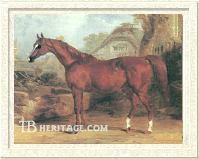
Emma | | EMMA (1824) was bred by the Earl's trustees, and later sold, or more likely leased, by coal magnate and banker William Russell who, in 1796, had purchased Brancepeth Castle, about four miles south of Durham. She was a modesty successful runner, winning three of her four juvenile races, including a 500 sovereign match against Sharpshooter at Doncaster, and place din four of her six races at age three, including third in Doncaster's Gascoigne Stakes to two colts. Retired to John Bowes' Streatlam stud, she produced seventeen foals, including two Derby winners -- Mundig and Cotherstone --Trustee, an influential sire in America, and Mowerina, the dam of English Triple Crown winner West Australian and other good winners.
|
MARIA (1827) was bred by the Earl's trustees, and ran in the name of Lord Darlington, who was created Marquis of Cleveland the year she was born. She was the best runner of Gibside Fairy's good daughters, winning a number of races, including the York Gold Cup and the Great Subscription Purse at York in 1831, the King's Plate at Lincoln, and a Silver Tureen and the King's Plate at York in 1832.
As a broodmare, Maria was lodged at, if not in the possession of, Thomas Thornhill of Riddlesworth, Norfolk, the owner of the great stallion, Emilius, who is credited with breeding six of her eleven live foals, every single one by Emilius, and a good "nick" it was. Their offspring included Euclid (1836), winner of the St. James's Palace Stakes, the Grand Duke Michael Stakes, and second to Charles XII, after a run-off, in the Doncaster St. Leger; Theon (1837), owned by Cleveland, who won some races at ages two and three and later was used as a hunter sire at Raby; the filly Extempore (1840), who won the One Thousand Guineas for Thornhill; and Mathematician, sold to ex-pugilist, gambler and sporting man John Gully, for whom he won the Great Ebor Handicap. Euclide and Mathematician were later good sires, and Extempore tail-female ancestress of some top horses, including English Triple Crown winner Flying Fox.
CAROLINE (1828), bred by the Earl's trustees, had a brief career on the northern turf as a juvenile, after being sold to the Marquis of Queensbury. She produced a number of daughters that bred on, forming the the branch of Family 7 - b that she heads. Many tail-female descendants won races in Germany, Austria, and Hungary. Derby winner My Love (1945) and Oaks winner Lovely Rosa (1933) descend from her via her daughter, Lady Emily (1842, by Muley Moloch). |
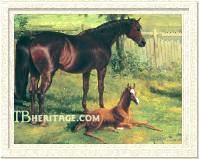
Maid of Lune | |
The liver chestnut MAID OF LUNE (1831) was one of the first horses to run, in York, in the colors of John Bowes after he reached his majority. Retired to stud in 1835, her first foal was Mickleton Maid (1836), by the good two-miler Velocipede. She won the Park Hill Stakes, and went on to produce some daughters whose descendants were successful and numerous enough to propel Maid of Lune to head her own branch of Family 7 (Family 7 - b), including some English classic winners and a great many successful horses in Japan. Another daughter of Maid of Lune, Heather Bell (1842, by Bay Middleton), was an important tail-female ancestress of top winners in South Africa. Maid of Lune remained in the Streatlam stud until her death in 1853, having produced fifteen foals for Bowes.
|
A Whisker Daughter in France
ADA (1824, Family 19 - a), from Anna Bella, a mare by Shuttle, along with MUSTACHIO and ABRON, took Whisker's blood to France, purchased by Lord Henry Seymour for his stud there. Bred to St. Leger winner Reveller, she produced Miss Annette (1830), one of France's most brilliant early running mares whose career on the turf lasted through age eight; Miss Annette was unbeaten at age five, her wins included the Prix Royal, the Grand Prix Royal, the Prix Principal, all at Paris, and a gold vase at Bruxelles, winning a total of 35,000 francs that year, an amazing sum for its time. In the stud, Miss Annette produced Annetta (1839, by Ibrahim), winner of many races at ages 3 and 4, including the Poule d'Essai des Poulains, and the Prix du Cadran; Annetta, in turn, produced three classic winners -- Bounty (1849, French One Thousand Guineas and French Oaks), Dame d'Honneur (1953, French Oaks) and Celebrity (1951, French Derby). Annetta's female line has had stakes winners, mostly in the U.S., up through the end of the 20th century. |
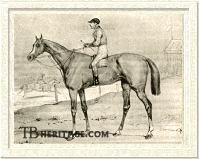
French Derby winner Poetess, a great broodmare, was out of Whisker's daughter, Ada | |
When ADA was later bred to Royal Oak (1825, by Catton), who was imported in 1833 and became one of France's most influential stallions in the early 19th Century, she produced Poetess (1838), winner of the Derby de Chantilly, the New Betting Room Stakes, the Prix du Jockey Club (French Derby), and two other races in her long six years on the turf for Lord Seymour. When Seymour's bloodstock was sold after his death, Poetess, who despite her French Derby win, had won only four races, and already partially crippled, was purchased by Alexandre Aumont for a mere 100 francs, and sent to his Haras de Victot in Calvados. There, she produced two of France's most influential horses, the great stallion Monarque (1852), and the outstanding runner and producer, Hervine (1848).
|
Poetess' son, Monarque (1852), won the French Derby, the Goodwood Cup and other top races and later became one of France's most influential sires, ever; among his progeny was the great French-bred winner of the English Triple Crown, Gladiateur. Poetess' daughter, Hervine, who won the French Oaks, the Prix du Cadran, and other important races in France, produced Mon Etoile (1857, by Fitz-Gladiator), winner of the Grosser Preis von Baden, and later tail-female ancestress of French Derby winner and sire Sea Sick (1905), St. Leger winner and sire Tracery (1909), the great French race mare Plaisanterie ( 1882), and many other good winners. Cambridgeshire Stakes winner Peau-Etre (1871), the great race mare and Grand Prix de Paris winner Tennebreuse (1884), Prix de Diane winner Serpolette (1880) and Grand Prix de Paris winer Birum (1956) are some of the winners descending from other Hervine daughters.
Poetess had a sad ending--left neglected after her broodmare career was over, and already crippled in the hind end, while tied in her paddock, she was tormented by boys, and fell, breaking her shoulder.
Other Whisker Daughters on the Turf |
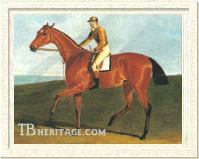
Ringlet | |
RINGLET (1821, mare by Star) was bred by Robert Jacques at Easby Abbey, Yorkshire. She was a good north country runner and was unbeaten in her juvenile year, always ridden by the celebrated northern jockey, John Jackson, when she won the Yearling Stakes at Catterick Bridge, and sweepstakes at Middleham, Richmond and Northallerton. At age three she won £50 at Northallerton, and the following year, at Kendal, won a £50 and the Town Plate. She was sold to Virginia in 1831, but died during the passage to the U.S. Her sister, MYSTERY (1824), was a modest runner, placing in races at Richmond.
|
|
Whisker's daughter, CATHERINA (1830, Family 6 - b), owned by her breeder, Mr. Barrow, ran 171 races between her first start in the Oaks of 1833 and her last run at Hednesford in 1841, and won seventy-five of them, many over a distance, including the Manchester Cup and Heaton Park's King's Cup. After her lengthy career on the turf, she went on to produce nine foals, her last at age twenty-seven. Her daughter, Sweetheart (1847, by Touchstone) won the July Stakes, and her son, Phaeton (1851, by Phlegon), was a good race horse that won the Criterion Stakes and King Edward Stakes. Her female line petered out after a few generations.
|
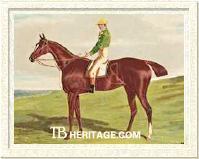
Fortitude 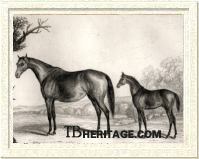
Delphine | | The chestnut filly FORTITUDE (1826, out of Fortuna, by Comus), bred and owned by Thomas Houldsworth, won both the Champion Stakes and the Gold Cup at Lincoln, and a sweepstakes at Chesterfield, and ran second to Sir Hercules in a sweepstakes for three year olds at Doncaster. In 1830, age four, she won a sweepstakes and silver tureen at York and the Queen's Plate at Lincoln, and ran second to Chorister in a race at York August and second to The Colonel in the Craven Stakes at Epsom. That year she also won a big sweepstakes at Newmarket, but the start was declared false, and the entire race was re-run, with Fortitude placing second. At age five she placed second in Epsom's Gavin Stakes, and in 1832, age six, she won the Heaton Park Stakes, the Manchester Stakes, and dead-heated in a free handicap at Liverpool. She had a brief career at stud, first for Houldsworth and later for Thomas Thornhill (owner of Emilius), and left nothing of note.
DELPHINE (1825), from the Comus mare My Lady (half-sister to The Colonel), won the Richmond Cup and the Northallerton Cup in 1828 for Edward Petre. She, like The Colonel, was later purchased by King George IV, and became a broodmare in the royal stud at Hampton Court, where she produced Monarch, purchased for $1,280 as a yearling and sent to America by his new owner, Wade Hampton II of South Carolina, where he was an unbeaten race horse and later had a long, successful career at stud. Monarch's year-younger sister, The Queen, was also purchased by Hampton and sent to the U.S. where she was sold, as a two-year-old for the then-record price of $6,000. Delphine's son, Herald (by Plenipotentiary), was also purchased by Hampton to the U.S., where he became good race horse. Finally Delphine herself was purchased by Hampton, for his Millwood Stud.
|
APOLLONIA (1826), sister to Delphine, was second dam of Ascot Stakes winner Buckthorn (1949), and Gimcrack Stakes winner Princess Royal (1855), and was fourth dam in tail-female of the great Australian racehorse, Chester (in-bred to Whisker, being a great-grandson of Cap--a-Pie) , winner of 19 of his 41 races, and unplaced only four times. Chester was later a multiple-time leading sire in Australia, primarily through his son, Abercorn, winner of the Sydney Derby at age three and the Great Metroplitan at age five, through Abercorn's sister Spice, Oaks winner at Sydney and Melbourne, and Dreadnaught, winner of both Australian St. Legers, the Victoria Derby and the 2-1/4 mile Australian Cup, carrying 118 pounds. Chester was in-bred multiple times to Whisker, with his second dam in tail-female, Austrey, by ECONOMIST'S son, Harkaway.
Other successful running fillies by Whisker included the brown LUNARIA (1824, from a Sancho daughter), owned by the Duke of Leeds, which won a race at Doncaster and the Old Stakes at Catterick in 1827. In the stud she produced a good runner in Jericho (1833, by Jerry). John Gully's Whisker filly, CLIO, ran second in Epsom's Craven Stakes in 1830. Whisker's daughter JANETTE (1821, later called LADY EASBY) ran second to the good horse Springkell in a race at Catterick in 1824 and was later the dam of winners. JENNY MILLS (1826), a half-sister to Hornsea, owned by Watts, ran second to Velocipede in a race at York in 1827; she was imported into the U.S., in foal to Plenipotentiary, by L. Polk of Tennessee in 1838, and she had winners in tail-female descent through the end of the 19th century. Another Whisker daughter imported into the U.S. was INVALID (1822, from Helen, by Hambletonian), who went to the Corbin brothers stud in Virginia.
The chestnut Whisker filly VICTOIRE (1828), bred and raced by George Walker, was a good juvenile in the north in 1830, running second in a sweepstakes won by Chorister at York Spring, and second to Frederica in Doncaster's Champagne Stakes. She ended up in the Riddlesworth stud of Thomas Thornhill, and was repeatedly bred to Emilius, but produced nothing of much significance. Her brother, REFORMER (1821), won the July Stakes. They were out Vourneen, by Sorcerer. |
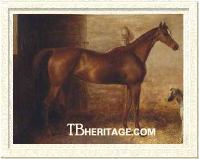
Taglioni | |
The long-running Whisker filly TAGLIONI (1827, from a Catton mare), owned by Mr. Clarke, won a sweepstakes at Lewes in 1830, and ran third to Elis in Goodwood's Racing Stakes in 1836. In the stud she produced some good running sons, including Retriever (1836, by Recovery), winner of Goodwood's Chesterfield Cup, the Goodwood Stakes, and the Worcester Cup, and a number of races in Ireland, and Tearaway (1838, by Voltaire), a winner in Ireland; her son Fireaway (1838, by Freney) was also a winner in Ireland, and daughter Danceaway was a good producer.
|
NITOCRIS (1829, Family 11 - g), a sister to MEMNON, out of Manuella, bred and owned by Richard Watt, won a big produce sweepstakes at York August in 1832, but ran unplaced in Doncaster's St. Leger. Nitocris was tail-female ancestress of a number of good horses, such as Fisherman (1853, NITOCRIS was third dam, in tail-female), winner of 70 racers in 131 starts, including the Ascot Gold Cup twice, and Great Yorkshire Handicap winner and sire Strathconan. Fisherman, who was by Heron, was sent off after one season at stud to Australia and became a highly influential sire there, getting some great runners, including Goldsborough, winner of the two mile Great Metrpolitan in 3:32-/14 at age five, carrying 129 pounds. Nitocris' and Memnon's sister, MARGELLINA (1826), became tail-female ancestress of many outstanding runners in a family that continues today; Epsom Derby winner Kingcraft, U.S. Triple Crown champion War Admiral, Oaks winner Sun Cap, French classic winner and sire Zeddaan, Grand National winner Cloister, and many others descend from Margellina in the tail-female line.
Other Whisker Daughters in the Breeding Shed
Other Whisker daughters that proved to be good broodmares included DIDO (1830), out of the Walton daughter, Miss Garforth. She produced Meteor (1839), by Velocipede, who won the Two Thousand Guineas. Conyngham (1844, by Slane) was another Two Thousand Guineas winner, who also won the Royal Hunt Cup and the King Edward VII Stakes; he was out of an unnamed Whisker MARE born in 1832, out of a Sam mare. Another unnamed Whisker MARE (1820) became the dam of Royal Hunt Cup and Hampton's Middlesex and Surrey Stakes winner Knight of the Whistle (1838, by Velocipede). Yet another Whisker MARE (1830, out of Matilda, by Comus) was the dam of Cambridgeshire Handicap Stakes winner Nat (1840, first named Prince of Wales ).
In the crop that the stallion Glencoe left in England before his shipment to the U.S. and glory, was the 1837 filly Darkness, winner of the Ascot Stakes and later tail-female ancestress of the French stallion, Plutus; she was out of Whisker's daughter, FANNY (1827, out of a Camillus mare). Whisker's daughter TESANE (1830, out of the Octavian daughter, Lady of the Tees, produced Ascot Stakes winner Teetotaller (1839). Through her granddaughter, Park Hill Stakes winner Ellerdale (1844), Tesane was third dam of Derby winner Ellington (1835) and Oaks winner Summerside (1856). MALIBRAN (1830), from another Octavian daughter, Garcia, produced two good winners in July Stakes winner Marsyas (1851, by Orlando), later a sire, and St. James's Palace Stakes winner Ionian (1841, by Ion); 2,000 guineas winner The Hermit (1851, by Bay Middleton), was a grandson of Malibran's.
An unnamed MARE by Whisker, out of the great broodmare Mandane, was bred in Richard Watt's Bishop Burton Stud in 1822. To the cover of Tramp she produced Liverpool (1828), a good stayer bred by Watt that won Doncaster's Gascoigne Stakes; Newmarket's Port Stakes, the York Cup, and the Stanley Stakes. He was sold to John Ramsay of Naworth Castle, Carlisle, at the end of his career and in the stud got the top handicap horse and influential sire, Lanercost; Two Thousand Guineas and St. James's Palace Stakes winner Idas, and some other good runners and producers..
Whisker got a number of other daughters that became tail-female ancestresses of good runners, among them a unnamed MARE (1822), bred by Lord Cleveland, that heads Family 3 - c, and MISS FOOTE (1824), from a Caleb Quote 'Em mare (Caleb Quote 'Em was second in the 1805 Doncaster St. Leger), who was taken to Ireland by Lord Sligo around 1820. She established a good line of steeplechasers, from whom descend Grakle and Shaun Spadah, both Grand National winners.
-- Patricia Erigero
|
|
|
|

